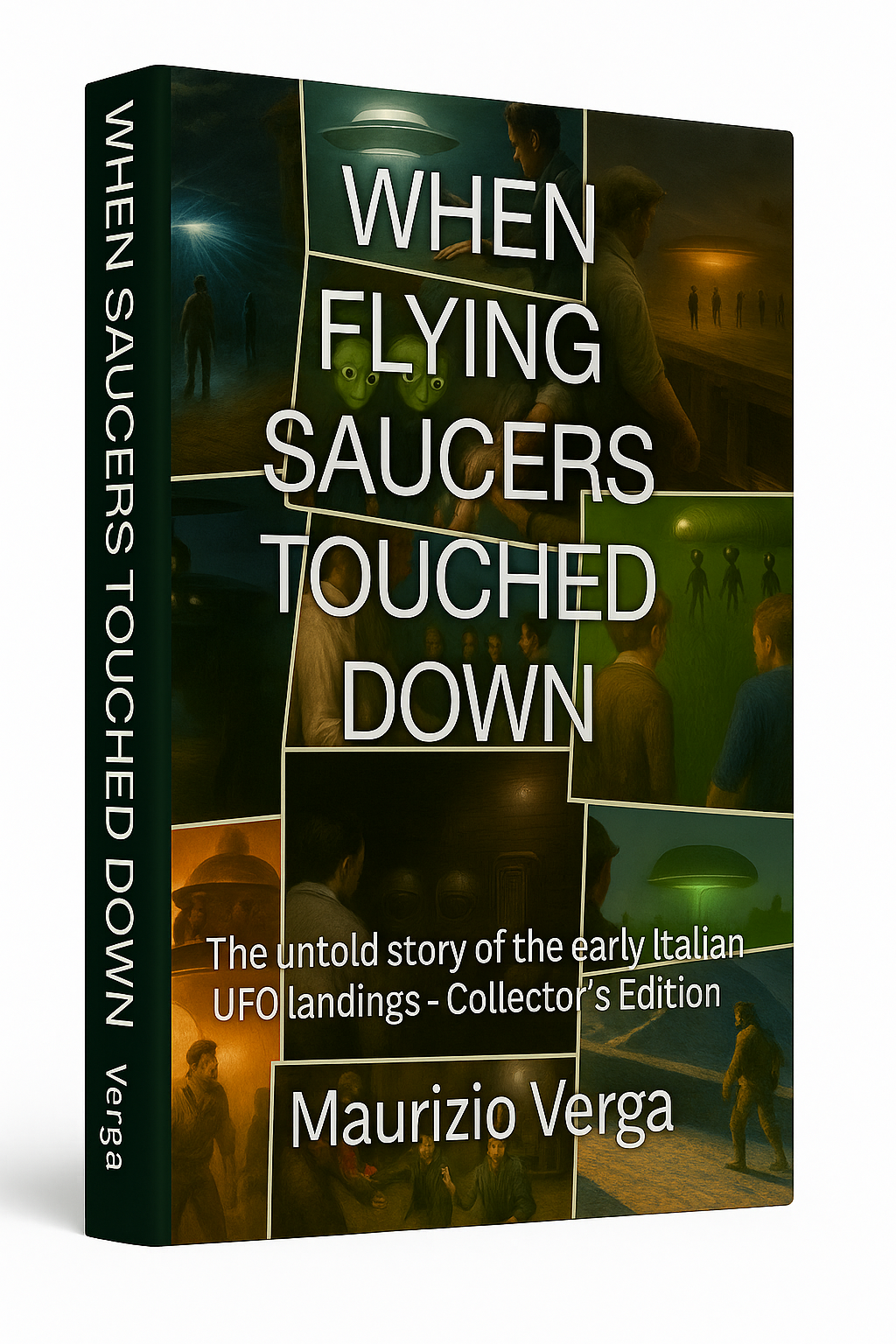On the morning of Thursday June 26, 1947 most American newspapers delivered their readers a curious news from an Associated Press dispatch. A man flying in his airplace over the North-West of the country (in search of the crash site of an airplane disaster happened months before) reported the sighting of nine “missiles” or anyhow odd objects flying at the stunning speed of 1,200 miles per hour.
Those contraptions had a bizarre course: the man said it looked like that of saucers thrown on a water surface and bouncing on it. The titlists of some newspapers liked the image of those saucers evoked by the witness. After all those guys were always in search of very short and simple sentences, to be understood immediately and powerful enough to visualize an image in the mind of readers.
In the title and the body of the articles began to appear the word “saucer” to describe those things reported by more and more people in the American skies. Just because they were “flying” they were soon named “flying saucers”, one of the more powerful and fascinating words of the XX century popular culture. You can find trace of the brand new name even on articles publiched on June 26.
A strong evocative image was associated to such saucers and day after day of that summer it was strongly spread by the press (in the US at first, then virtually everywhere, though in different ways) and consequently more and more in depth into the popular imaginary, till consolidating and becoming an ultimate heritage of the popular culture. The image of saucers was strong because of the combination of a shape, that unusual to be inevitably the product of a super-advanced technology (therefore a mysterious one), with the action of flying, specifically a flight displaying fantastic performances.
The press was the key for the disclosure of the primigenial news, but above all it was the key for the success of the sighting stories among most readers, who quickly fell in love or even went crazy for them. Thanks to the concomitance of some lucky circumstances the majority of the newspapers of that time devoted a large or even very large space to the sightings, though emphasis and comments were varied. Several papers published large headlines and articles on their front pages (often more than on the same front page), while others had many different articles scattered in the same edition (mainly between July 7 and 10). They published letters from readers, pictures and cartoons, often giving some sort of reliability to the tales of the people reporting the sightings. Other newspapers had smaller coverage, usually just repriting the dispatches from the wire services. Some other papers gave a very small space to those stories, usually after July 5 or 6, when it was strictly necessary because of the emerging power of the saucers in all over the country, even though they were treated as pure nonsense. Local weeklies usually had a restrictive approach, devoting very few or even no space to the argument: they had few pages entirely devoted to the every day life and events of their territory. When they published something it was just to say that something had been seen in their own area too.
The predisposition (in that precise time frame) of the newswire services and, as a consequence, of the newspapers to devote some space to the unusual stories of citizen reporting something weird flying in the sky was helped and boosted by some other factors too.
A few of them:
- An impetuous techno-scientific development, seen nearly like some sort of “magic”. It made plausible the presence of flying machines with unimaginable performances.
- The cold war with the Soviet Union. It made possible the threat of foreign planes or “missiles”, possibly developed after the amazing nazi techologies that were regularly reported and fantasized since 1945.
- The presence of a seemingly reliable witness, namely a pilot who was flying, and flight was a serious business.
- The predisposition of a minority of the population in believing that there was a possible connection between the new sky intruders and the fantastic stories about martians and their contacts published in the previous decades by the newspapers, the Sunday comics and the sci-fi pulp magazines.
Without the combination of all those elements (and others) in an appropriate temporal and geographical frame, and without the presence of other witnesses that at mid day of that Thursday June 26 (after reading the very first news about the Arnold sighting) got in touch with some reporter to tell they too had seen something unusual, the flying saucers would have remained just a curious news appeared in the US press in the early summer of 1947.
Though the Arnold story was published just less than 24 hours later (on June 25) by the local newspaper “East oregonian”, on June 26 it was published by hundreds of American dailies. At this time we found more than 350 of them, and about 150 newspapers published an article on their front page. The story was mostly published in other pages, usually a quarter of a column. In some cases it covered important placements on the front pages, rarely with titles of three or more columns.
[envira-gallery id=”3850″]
For example, The Oregon Statesman had a five-colum long article in the front page, probably the most detailed one (together with the one from the Herald and News) that day describing the Arnold episode.
The Nort-West newspapers were those dealing more with the story of the sighting, likely because it happened just in that same area. In the following days and weeks many of them published a great quantity of articles (and of physical space on the paper!) about the local and national sightings, comments, cartoons, advertisements and custom news related to the flying saucers. Again on June 26 the last edition of a Seattle newspaper had a top headline introducing the sightings of other witnesses indirectly confirming the Arnold’s tale, making it stronger and more believable.
The day after a Texas newspaper (but others did the same) published a large headline, running across the front page in its last evening edition, announcing other witnesses who, after reading the news of the Arnold sighting, contacted reporters to tell what they saw. The many articles published in the morning of june 26 were a sort of detonator triggering a “me too” phenemomenon pushing more and more people to tell their local newspapers what they had seen after (or even before) June 24. A “snowball effect” that generated the peak of July 7 and 8, then melting pretty quickly. Despite this a strong trace remained and it encapsulated into the popular culture with a stunning strenght and speed. Why this? Likely it was due to the right context and to the presence of specific motifs in the imaginary of the time (for example: the idea of the existence of martians technologically and scientifically much more advanced than humankind) that fitted well with the mystery of the outlandish flying objects showing stunning performances.
[envira-gallery id=”3852″]
Front page headlines reappeared on July 4, but above all on July 5. It was the beginning of a five-day period that saw the overwhelming explosion of the wave of sightings. All parts of the American society were touched by such saucer craze thanks to a massive media coverage (including also the radio). Such a coverage was fueled by the unexpected interest of the public for the saucers and it interacted deeply with them, following a reciprocal process of cause-effect.
Between July 7 and 8 large headlines running across the whole front page were several, but even more those with showy headlines places in lower sections of the front pages. Starting July 9 they became fewer and then extremely rare after July 10.
Very large headlines delivering a great visual and emotional impact were specific of the American scene. A noteworthy exception was Brazil (and Mexico in a lesser extent), where some newspapers published even larger headlines on their front pages starting on July 8 and untill the end of that month.
Saucer headlines were unthinkable for the European newspapers (and the Italian ones, which had as little as four pages due to post-war paper shortage), even in the early fifties when the phenomenon had become really popular in all over the old continent. There were rare exceptions, for example the Milan newspaper “La Notte” on october 21-22, 1954.
Most large headlines on the front pages of 1947 could be grouped in few topics:
- local sightings (“they arrived here too”)
- the spread of sightings in more and more states (“increasingly people saw these things, so something real must be out there”)
- planes patrolling the skies hunting the saucers (“we want to find them, and see them closely”)
- the “saucer” recovered by the Army at Roswell (“at last the Army got one of them, so the mystery will be solved”)
[envira-gallery id=”3866″]
In most headlines there was a more frequent use of terms like “disc” and “disk” than in titles of articles published in inside pages. Likely it was just a simple choice of titlists for shorter words better fitting the limited lenght of those titles.
The visual and emotional power of these headlines (we just offered a small selection of those actually published) was definitely remarkable. They showed the “mediatic weight” gained by the saucers; the press rewarded such a “weight”with those unusual spaces satisfying the fascinated curiosity of the readers. More, those headlines contributed to generate new interest in saucers, new awareness about the presence of strange things in the sky and ultimately new sightings from who felt authorized to see himself what was reported by the newspapers, becoming a protagonist of that extraordinary popular event[1].
Then all ended quickly, in less days than those previously necessary to reach the peak. But just apparently. The saucers in those headlines remained firmly docked to the imaginary of a majority of the population, not only those who believed the stories reported by the newspapers, but even those who just smiled or laughed at them.







